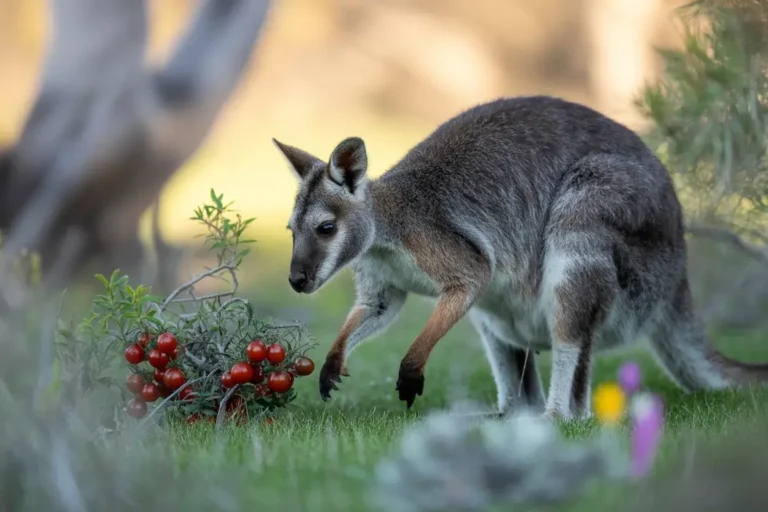Wallabies Habitat: Natural Environments and Ecosystems
Wallabies, the small relatives of kangaroos, are native to Australia and nearby islands. Their adaptability to various environments is one of the key reasons they thrive in such diverse landscapes. From dense forests to rocky outcrops and wetlands, wallabies are found in a variety of natural habitats. In this article, we’ll explore the different environments where wallabies are found in the wild and how these ecosystems support their survival.
Forests: The Preferred Shelter of Wallabies
Wallabies are commonly found in Australia’s forests, where they seek shelter and forage for food. These areas provide the perfect conditions for wallabies to thrive, offering dense vegetation, shelter, and abundant food sources.
Wallabies in forests tend to be more solitary than their open-plains cousins. The thick undergrowth helps them stay hidden from predators like dingoes and foxes.
Rocky Areas: Rugged Terrain for Agile Wallabies
Wallabies are also commonly found in rocky terrains, especially species that are adapted to climbing and navigating challenging landscapes. These areas offer a unique combination of shelter and food sources, making them ideal for certain wallaby species.
Rocky environments are particularly beneficial for wallabies as they offer protection from larger predators, and the high vantage points make it easier for wallabies to spot potential threats.
Wetlands: Life in Swamps and Marshes
In addition to forests and rocky areas, wallabies can also be found in wetlands. These damp environments are home to a variety of plant species that wallabies feed on, such as grasses and aquatic vegetation. Wetlands are abundant in eastern Australia, where many species of wallabies have adapted to living in marshy conditions.
Wetlands offer wallabies a peaceful and abundant environment, although they must also deal with the challenges of humidity, flooding, and competition with other animals for food sources.
Grasslands and Savannas: Open Areas for Some Wallaby Species
While many wallabies prefer dense forests and rugged terrain, some species are well-suited to open grasslands and savannas. These habitats offer wide spaces for grazing, and some wallabies have adapted to life in these open areas.
Grasslands and savannas offer wallabies wide open spaces, but they also expose them to predators, such as dingoes. Wallabies in these environments are often more social and tend to form groups for protection.Suburban Areas: Adaptation to Human Environments
Suburban Areas: Adaptation to Human Environments
Interestingly, some wallabies have adapted to living in suburban areas, where they can find food in gardens and parks. These environments provide wallabies with an abundance of plants and minimal natural predators. However, living in human-dominated areas comes with challenges, such as traffic and habitat loss.
While wallabies in suburban areas are relatively safe from large predators, they are vulnerable to human interference, and their long-term survival depends on the protection of their natural habitats.
Key Habitats of Wallabies: A Quick Overview
Habitat Type | Common Wallaby Species | Key Features |
|---|---|---|
| Rainforests | Goodfellow’s Wallaby, Swamp Wallaby | Dense vegetation, high humidity, fruit-bearing plants |
| Rocky Areas | Rock Wallaby, Yellow-footed Rock Wallaby | Rugged terrain, cliffs, predator protection |
| Wetlands | Swamp Wallaby, Black Wallaby | Swamp grasses, water plants, dense vegetation |
| Grasslands | Eastern Grey Wallaby | Open space, grasses, grazing areas |
| Suburban Areas | Various species | Urban parks, gardens, human-modified environments |
FAQs About Wallabies’ Habitat
1. Can wallabies live in the desert?
While most wallabies prefer wetter or forested environments, some species, like the Mallee Wallaby, are adapted to survive in arid and semi-arid regions with sparse vegetation.
2. Do wallabies need water to survive?
Yes, wallabies need access to water. However, species living in drier areas have adapted to survive with less frequent access to water by feeding on moisture-rich plants.
3. Are wallabies endangered in certain habitats?
Some wallaby species, especially those living in highly specialized habitats like coastal cliffs or rainforests, are considered endangered due to habitat loss and fragmentation caused by human activity.
4. How do wallabies adapt to living near humans?
Wallabies that live in suburban or urban areas have adapted by foraging in gardens and parks, but they still face threats like traffic, dogs, and habitat destruction.
Conclusion
Wallabies are incredibly adaptable animals, thriving in a wide range of natural environments, from lush rainforests to rocky outcrops and wetlands. Their ability to survive in diverse ecosystems showcases their resilience and versatility. As human activity continues to impact the environment, it is crucial to protect the natural habitats of wallabies to ensure their continued survival. Whether in dense forests, rugged mountains, or even suburban areas, wallabies are an essential part of Australia’s rich biodiversity.


